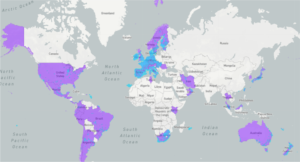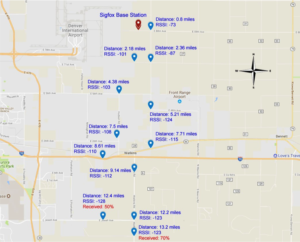
There are numerous wireless standards available today for connecting devices and sensors.
Choosing the right one for your IoT solution depends on your specific needs and applications. In this article, you will learn about:
- Traditional solutions (i.e. cellular, WiFi, Zigbee, BLE)
- Emerging wireless standards (LoRa®, Sigfox, NB-IoT)
- Measuring range
- Measuring battery life
Traditional Solutions: Cellular, WiFi, Zigbee, BLE
For many years, cellular wireless technology has been used to connect devices to the internet. Until now, cellular has been a viable and reliable solution for wireless WAN connectivity.
However, the technology does have its limitations.
Many wireless modules that use cellular technology are costly to purchase and deploy. Cellular wireless technology is often overly complex for simple sensors, which send data infrequently and don’t require significant bandwidth.
Cellular networks also consume a lot of energy. Consequently, deploying devices on cellular networks requires rechargeable batteries that must be energized often. Finally, cellular networks come with expensive data plans. Businesses and users incur larger costs when connecting wireless devices via cellular technology.
Traditional alternatives to cellular technology include WiFi, Zigbee, and BLE. Although effective for transferring large amounts of data over the internet, these standards are limited by short data ranges, heavy power consumption, and built-in complexities. Reconfiguring simple sensors with no user interfaces in the field is especially burdensome with these technologies.
Fortunately, there is a new class of wireless standards that are built specifically for short-range digital data transfer. These standards are far less costly and don’t consume nearly as much energy from devices. As a result, they have become increasingly popular as Internet of Things (IoT) devices and applications continue to enter the market.
New Wireless Standards: LoRa, Sigfox, NB-IoT
LoRa, Sigfox, and NB-IoT are the leading emerging standards in the wireless sensor space.
Commonly referred to as Low Power Wide Area Networks (LPWANs), these standards connect simple battery-powered sensors to the cloud in a low-cost, efficient manner.
Below, we explain how each standard works.
LoRa
LoRa® is a widely accepted wireless standard that supports data transmission over long distances using a chirp spread spectrum modulation scheme. Sitting on top of LoRa is LoRaWAN®, a layer specification that is openly available to the public. Devices connect to LoRa networks through gateways or LoRaWAN network providers.
Every LoRaWAN end device must connect to a LoRaWAN network server. LoRaWAN network servers manage provisioning, joining, and decryption of data payloads. They also manage gateways and end devices, which can have unique device IDs, application IDs, and application key functionalities, as well as pictures of RB sensors with IDs.
Through MAC command downlinks, LoRaWAN servers can reconfigure the characteristics of end devices, including channels, data rates, and output power. The technology also provides message acks and downlink routing and timing for receive windows.
LoRaWAN network servers can be set up in several ways. They can be hosted in the cloud and rely on gateways for packet forwarding. With this approach, users get free services, such as access to The Things Network (TTN), and have access to paid services, like machineQ and Senet. LoRaWAN servers can also be deployed on privately dedicated network servers.
LoRa coverage can easily be expanded through low-cost gateways and multiple gateways can be managed simultaneously. Overall, private networks are low cost and easy to set up.
There are several limitations to LoRaWAN networks. In Europe, there are only 8x125k uplink channels, as compared to 64 in the U.S. There are also restrictions on air time, including LBT and duty cycle/holdoff requirements, and transmit integrity is monitored by sequence number continuity.
Alluded to above, several public LoRaWAN providers have emerged.
machineQ is a division of Comcast that supports a reliable and stable LPWAN based on Actility. Gateways “packet forward” to the machineQ NS. Users can connect to machineQ gateways for $39 per month and don’t have any data limitations or per device fees. In MSP metro for example, there are two public machineQ towers.
The Things Network Coverage Map |
The Things Network is a publicly supported network in which gateways can packet forward data to the network. Users can purchase their own gateways and don’t have to pay any fees per devices. The network has coverage in most U.S. states and over major metropolitan areas in Mexico. Two limitations of TTN are that coverage is limited by cheap gateways and Europe’s TTN Fair Access policy limits how many acks and how much time can be spent on uplinks. |
Senet Coverage Map |
Senet is another major deployer of stable LPWANs on the LoRa standard. Senet has public base stations available in many major U.S. cities. Users can add gateways as packet forwarders but have limited data uplinks/downlinks available depending on their data plans. Senet networks follow the pay-per-device model and allow users to purchase blocks of sensors (minimum 150). Contract discounts are available if gateways are added to networks. |
Sigfox
Sigfox Coverage Map |
Sigfox is a network and protocol that connects devices directly to base stations. The standard can transmit data over very long ranges. However, data rates are slow and no message acks are provided. Data packets are limited to 12 bytes and downlinks are very limited, as they only happen when requested. |
Sigfox uses ultra narrowband transmissions and all networks across the world use one common interface. The technology can support 4k channels and 100+ channels per sub-band at 600 bps in the U.S. and 100 bps in Europe. Overall, Sigfox has coverage in more than 55 countries.
Those who deploy wireless sensors on the Sigfox network pay per device and by how many uplink/downlink messages are transmitted. Sigfox manages network infrastructures, which can be extended as needed.
Radio Bridge also develops wireless sensors for the Sigfox protocol. We provide connectivity to the Sigfox network with plans starting under $1 per month. Without using any gateways or wiring, deploy wireless Sigfox sensors wherever you need for your application. Options to expand Sigfox coverage with base stations and gateways begin at $450.
NB-IoT Coverage from T-Mobile |
NB-IoT is another new wireless standard through which sensors can be connected to LPWANs. NB-IoT uses guard bands for narrow channels, which enables the standard to avoid interfering with CAT-M1 and other fast channels. Compared to CAT-M1, NB-IoT does have a better link margin. On top of that, band 71 with NB-IoT has deep indoor penetration at 600MHz.
In the summer of 2018, T-Mobile added NB-IoT coverage to its 4G network. |
When is each wireless standard used?
The wireless standard you choose depends on your future application.
For distributed applications, Sigfox and NB-IoT are the most effective options. Each standard requires coverage in every home, which is appropriate for low-event applications (i.e. emergency alerts). Additionally, both standards can be deployed for mobile applications, such as trucking and shipping.
For clustered applications, LoRaWAN is the best option. A single LoRaWAN gateway can cover all units in an apartment building or all rooms in a hotel. The standard is especially valuable for frequent event applications, such as those involving measurements every 15 minutes.
Measuring Range
Statistics around open air range can be misleading. Most emerging wireless technologies can send data through many miles of unobstructed air. Real-world applications, however, rarely operate in truly open air environments. In urban environments for example, wireless sensor ranges are much shorter as they are impacted by a number of variables. These include the presence of concrete or metal barriers, reflections, antenna orientations, and transmission frequency.
LoRa Range Testing |
Radio Bridge has achieved over 22 miles of line-of-site distance to a LoRaWAN tower with their indoor sensor products as shown here. However, this was performed at a location 600 feet above the city of Denver and was thus true line of sight. Similarly, the Sigfox version of these sensors was tested up to 13 miles to a Sigfox tower. |
Sigfox Range Testing |
In the Sigfox range testing, the measurements were performed on flat ground and the connectivity was only lost because the elevation dropped and line of sight was lost.
This should not be considered an “apples-to-apples” comparison against the LoRa range testing shown above due to the lack of elevation. |
Urban Range Testing |
In urban environments, our sensors have been tested up to a mile depending on the access points and device locations.
In this image, measurements were taken in and around downtown Denver relative to an indoor gateway. |
Battery life
Much like measuring range, battery life estimates can also be misleading. Sensor manufacturers often quote 5-10 years on a single battery, but this is highly dependent on usage. For high message-rate applications, battery life depends on transmit power, which is measured by the number of transmissions.
For low message-rate applications, battery life is based on sleep currents. This calculation includes battery self-discharge rates. Radio Bridge has a wireless sensor battery estimator to help you calculate the battery life of any sensor, regardless of which wireless standard you choose.
For more information on how Radio Bridge helps organizations deploy wireless sensor technology for the Internet of Things industry, visit our website at radiobridge.com





